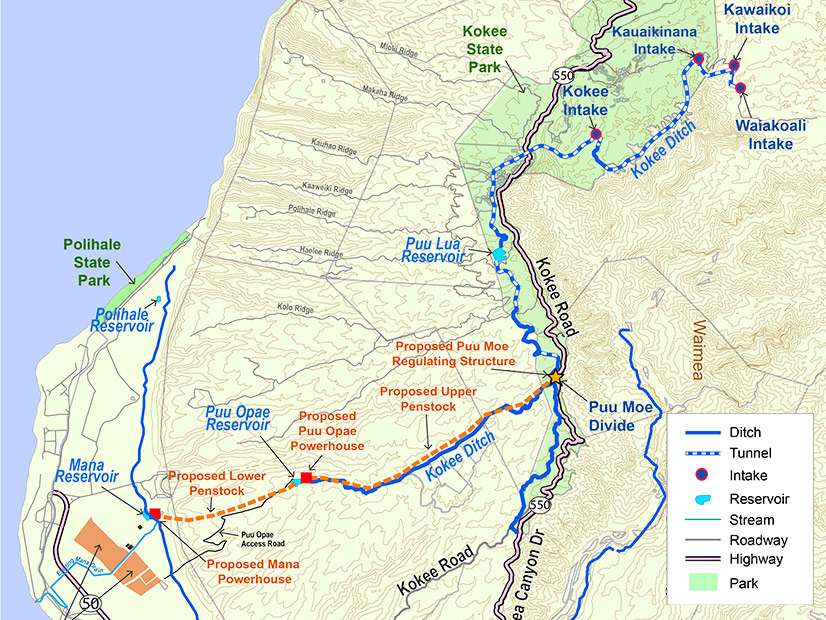Kauai residents are concerned about the details of a proposed solar plus pumped hydro storage project that Kauai Island Utility Cooperative (KIUC) says could produce a quarter of the island’s energy requirements.
KIUC is working with AES to build the $200 million West Kauai Energy Project (WKEP) in an effort to extend the availability of solar-generated energy into the overnight hours.
The utility is awaiting approval from the Hawaii Public Utilities Commission to build a 35-MW solar array and 70-MWh battery storage system on 350 acres in the Waimea district of western Kauai. The energy produced would feed into the grid and pump water into an underused reservoir, which would be released at night through turbines to produce power.
The proposed storage value of the project is hefty: The pumped hydro portion would store a potential 1,500 MWh of energy, a much larger payload than Kauai’s two battery storage systems from AES (100 MWh) and Tesla (52 MWh).
Called “the first project of its kind in the world” by KIUC CEO David Bissell, WKEP aims to produce 25% of Kauai’s energy requirements, pushing the utility past its goal of generating 70% of its power from renewables by 2030. WKEP is projected to reduce GHGs by 80,000 tons per year. Bissell described WKEP as a “legacy” project that can be used for at least 100 years.
WKEP’s design will attempt to use fragmented infrastructure. Three reservoirs at different elevations, Mana, Pu’u Opae and Pu’u Lua, are underused and do not meet Hawaii’s dam safety standards. WKEP would connect the reservoirs via underground pipes and a ditch, place two hydroelectric turbines at key points and pump water up as needed. The reservoirs are designed to be used for irrigation and firefighting, so the ability to refill them as needed provides reliability. Pu’u Lua is also host to a trout fishing program, which would be bolstered by the rejuvenation of the reservoir.
Pumped storage is a vital aspect of WKEP, according to KIUC. “Solar plus storage technology provides short-term energy dispatch, around four to five hours,” but that would not manage an entire evening or long periods of cloud cover, the utility said.
The project’s design provides a simple system for increasing reliability: If batteries fail or fossil fuel plants trip offline, operators can open the reservoir gates and let water fall through turbines. It also minimizes the amount of shipping and recycling required once batteries degrade.
Residents Call for EIS
As eco-friendly as the project sounds, Kauai residents voiced concerns about it during a March 31 open house meeting with KIUC and AES. Some wondered why community solar would not be used to power the water pumps.
One resident asked whether KIUC receives a tax credit when it develops a solar farm and does not “use current solar panels that are already in the grid.”
“Tax credits are a part of that,” KIUC’s Bissell said. “To maintain and protect the tax credits associated with the project, we cannot take any energy from the grid for the first five years of operation.” WKEP could “potentially” draw from other solar resources after that, he said.
Another resident asked how much of WKEP’s energy would be produced by the hydroelectric portion of the project rather than solar.
“The solar panels are the ultimate source of most of the energy in this project,” Bissell said. “It’s a combination of solar panels and incremental hydro. … The incremental hydro is a relatively small part of what the water does. It helps make up for the efficiency in running the pumps versus a battery, and it’s what makes the project competitive… The water is necessary to make the solar project work.” He explained that the pumped hydro functions as a makeshift battery, which is preferable because “battery storage is too expensive.”
Several residents voiced concerns about the project disrupting nature and called for an environmental review. They asked whether wildlife would be disturbed and if the Waimea River, the primary water source for the project, would be affected. They also wondered about the impact of increasing the size of the reservoirs, and if the potential for discharge would affect coral reefs.
KIUC and AES officials responded that the project would rely on underground piping to avoid disturbing wildlife and that the Waimea River’s natural flow would be maintained. They said that rehabilitation and increased safety standards would ensure the reservoirs are safe. They acknowledged what is not used for irrigation would be discharged.
“I feel like an EIS [environmental impact statement] is 110% required for this project” one resident said, prompting another to ask, “Why are we not doing an EIS?”
Earthjustice attorney Elena Bryant said that the utility’s presentation at the open house didn’t specify what proportions of the diverted river flows would be used to generate hydropower, supply agricultural needs, be lost through evaporation and seepage, or be dumped or discharged.
“Another question that remains unanswered is how the project is going to be integrated and coordinated with the operations of [the Agribusiness Development Corporation] and [Kekaha Agriculture Association] to ensure maximum, reasonable, beneficial use of any and all diverted flows for actual water needs of bona fide agriculture,” Bryant said.
Dawn Huff, a consultant for KIUC, said the utility produced a draft EIS but not a final one. “We decided to follow the standard environmental review process and start with an EA [environmental assessment].”
“Ultimately, the decision to move to an EA was because we didn’t have any significant impacts that were found from all the studies that were done,” Bissell said.
KIUC expects to submit the EA to Hawaii’s Department of Land and Natural Resources this spring. If approved, WKEP is projected to become operational in 2025.



